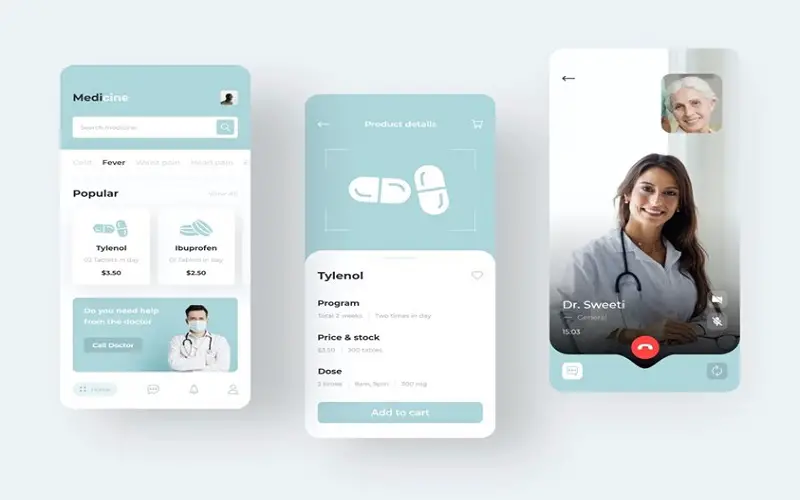UX design has become an increasingly important part of digital healthcare. UX (user experience) design is the process of creating products that are easy to use and enjoyable for users, ultimately leading to improved patient outcomes. In this blog post, we’ll explore some of the best UX web design concepts specifically tailored for healthcare providers and patients alike. We’ll discuss how UX can help create a better online environment for both doctors and patients, as well as look at examples of successful UX designs in action. By understanding these concepts, you can better position yourself to provide excellent care through your website or app!
Overview of UX Design in Healthcare
UX design is all about creating a seamless, effortless experience for users. With UX in healthcare, the goal is to make it easier and more intuitive for both providers and patients to navigate web pages, apps, etc. UX designers focus on crafting sites that are visually appealing while still providing an enjoyable user experience. UX in healthcare also helps shape content so that it’s easy to read, understand, and use. UX design is an essential component of any healthcare provider’s digital presence – it can make or break your patient engagement!
Best Practices for UX Design in Healthcare
When it comes to UX in healthcare, certain best practices can help you create an optimal experience for users. Here are some key concepts to consider:
- Create a seamless user flow. UX designers need to pay particular attention to the flow of web pages and apps to ensure users can navigate them easily. Creating intuitive user flows helps users quickly access the information they need.
- Design for mobile-first. UX designs should be tailored to accommodate a variety of devices, including both desktops and mobiles. The UX design should be optimized so users can easily navigate your website or app on any device.
- Focus on usability and accessibility. UX designers should always keep usability and accessibility in mind when creating UX designs. This means ensuring that content is legible, navigation menus are clearly labeled, and buttons are easy to find and click.
- Prioritize communication. UX designers should prioritize clear communication between patients and providers. This includes making sure contact forms are easy to complete, chatbots are responsive, and appointment scheduling options are readily available.
By following these UX design best practices, you can create a better online experience for both healthcare providers and patients. UX designs should be tailored to the individual needs of each user, ensuring they have access to the information they need quickly and easily.
How to Implement UX Design into Your Health Care Website or App
If you want to create an effective UX design for your healthcare website or app, here are a few tips to help you get started:
- Understand Your Users – It’s important to know who your users are and what they’re looking for from your website or app. Conducting user research can help you determine their needs and expectations.
- Design with Purpose – UX design should always be tailored to the specific needs of your users. This means designing each page and feature with a purpose in mind, so users can easily access what they need.
- Focus on Usability – Make sure your designs are easy to use and understand by incorporating usability testing into your development process. This will help ensure that users can navigate your website or app quickly and easily.
- Prioritize Accessibility – UX designs should prioritize accessibility by ensuring content is legible, navigation menus are clearly labeled, and buttons are easy to find and click. This will make it easier for all users to access the information they need.
- Test and Iterate – Finally, it’s important to continuously test and iterate your UX designs. This will help you identify any areas that need improvement and ensure users are getting the best experience possible.
Following these tips can help you create a better online experience for both healthcare providers and patients. By understanding UX design principles and best practices, you can build an effective UX design that meets the needs of your users and improves patient engagement.

Tips for Creating an Effective and Engaging User Experience on Your Health Care Platforms
Creating a user-friendly experience on your healthcare platform is key to cultivating patient engagement. Here are some tips to keep in mind when designing your UX:
Make Content Accessible: Designing content that’s easy to digest and understand can help make it more accessible for users. Incorporate visuals, such as images, videos, and icons, to break up content and make it easier for users to digest.
- Incorporate Engaging Elements: Integrate interactive elements, such as surveys or quizzes, into your platform to keep users engaged. This will encourage them to stay on the website or app longer and provide more value.
- Focus on Navigation: Make sure your website or app is easy to navigate by including clear labels, categories, and search bars. This will help users quickly access the information they need.
- Prioritize Design Consistency: Keeping design elements consistent throughout your platform can help create a seamless experience for users. Use fonts, colors, and imagery that are consistent across all pages and features.
- Incorporate Feedback: Incorporating user feedback can help you identify areas that need improvement. Ask users for their honest opinion and use their feedback to optimize your design.
By following these tips, you can create a more engaging user experience on your healthcare platform and improve patient engagement. With the right UX design, you can ensure users have access to the information they need quickly and easily.
Conclusion
UX design is essential for creating a successful healthcare platform. Following best practices and incorporating user feedback can help you create an effective and engaging user experience that meets the needs of both healthcare providers and patients. Implementing these tips into your UX design process can greatly improve patient engagement and optimize your platform for success.




